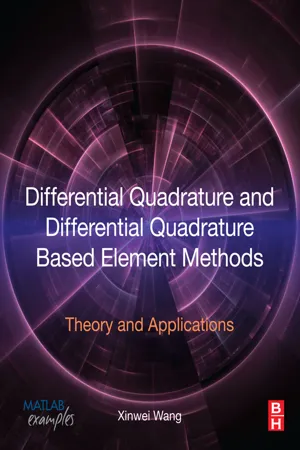
eBook - ePub
Differential Quadrature and Differential Quadrature Based Element Methods
Theory and Applications
- 408 pages
- English
- ePUB (mobile friendly)
- Available on iOS & Android
eBook - ePub
Differential Quadrature and Differential Quadrature Based Element Methods
Theory and Applications
About this book
Differential Quadrature and Differential Quadrature Based Element Methods: Theory and Applications is a comprehensive guide to these methods and their various applications in recent years. Due to the attractive features of rapid convergence, high accuracy, and computational efficiency, the differential quadrature method and its based element methods are increasingly being used to study problems in the area of structural mechanics, such as static, buckling and vibration problems of composite structures and functional material structures.
This book covers new developments and their applications in detail, with accompanying FORTRAN and MATLAB programs to help you overcome difficult programming challenges. It summarises the variety of different quadrature formulations that can be found by varying the degree of polynomials, the treatment of boundary conditions and employing regular or irregular grid points, to help you choose the correct method for solving practical problems.
- Offers a clear explanation of both the theory and many applications of DQM to structural analyses
- Discusses and illustrates reliable ways to apply multiple boundary conditions and develop reliable grid distributions
- Supported by FORTRAN and MATLAB programs, including subroutines to compute grid distributions and weighting coefficients
Frequently asked questions
Yes, you can cancel anytime from the Subscription tab in your account settings on the Perlego website. Your subscription will stay active until the end of your current billing period. Learn how to cancel your subscription.
At the moment all of our mobile-responsive ePub books are available to download via the app. Most of our PDFs are also available to download and we're working on making the final remaining ones downloadable now. Learn more here.
Perlego offers two plans: Essential and Complete
- Essential is ideal for learners and professionals who enjoy exploring a wide range of subjects. Access the Essential Library with 800,000+ trusted titles and best-sellers across business, personal growth, and the humanities. Includes unlimited reading time and Standard Read Aloud voice.
- Complete: Perfect for advanced learners and researchers needing full, unrestricted access. Unlock 1.4M+ books across hundreds of subjects, including academic and specialized titles. The Complete Plan also includes advanced features like Premium Read Aloud and Research Assistant.
We are an online textbook subscription service, where you can get access to an entire online library for less than the price of a single book per month. With over 1 million books across 1000+ topics, we’ve got you covered! Learn more here.
Look out for the read-aloud symbol on your next book to see if you can listen to it. The read-aloud tool reads text aloud for you, highlighting the text as it is being read. You can pause it, speed it up and slow it down. Learn more here.
Yes! You can use the Perlego app on both iOS or Android devices to read anytime, anywhere — even offline. Perfect for commutes or when you’re on the go.
Please note we cannot support devices running on iOS 13 and Android 7 or earlier. Learn more about using the app.
Please note we cannot support devices running on iOS 13 and Android 7 or earlier. Learn more about using the app.
Yes, you can access Differential Quadrature and Differential Quadrature Based Element Methods by Xinwei Wang in PDF and/or ePUB format, as well as other popular books in Computer Science & Computer Engineering. We have over one million books available in our catalogue for you to explore.
Information
Table of contents
- Cover
- Title page
- Table of Contents
- Copyright
- Preface
- Acknowledgments
- Chapter 1: Differential Quadrature Method
- Chapter 2: Differential Quadrature Element Method
- Chapter 3: Methods of Applying Boundary Conditions
- Chapter 4: Quadrature Element Method
- Chapter 5: In-plane Stress Analysis
- Chapter 6: Static Analysis of Thin Plate
- Chapter 7: Linear Buckling Analysis of Thin Plate
- Chapter 8: Free Vibration Analysis of Thin Plate
- Chapter 9: Geometric Nonlinear Analysis
- Chapter 10: Elastoplastic Buckling Analysis of Plate
- Chapter 11: Structural Analysis by the QEM
- Appendix I
- Appendix II
- Appendix III
- Appendix IV
- Appendix V
- Appendix VI
- Appendix VII
- Appendix VIII
- Appendix IX
- Index